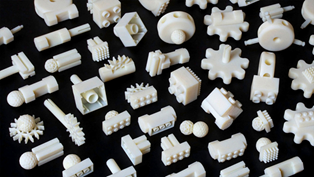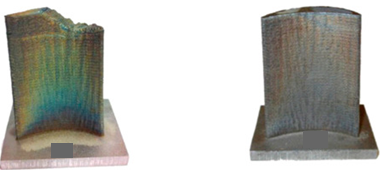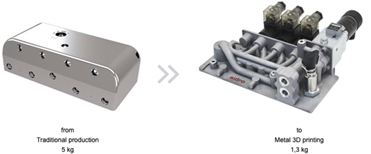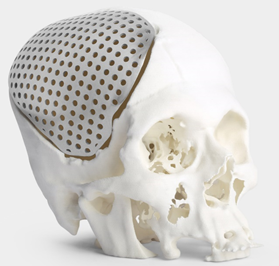Additive Manufacturing: Creating Value beyond Part Printing
Written by Priyanka Nadig 08 Apr, 2021
One of the key aims of a manufacturing company is to have the fastest time-to-market in delivering solutions that meet industry demands. Digital transformation initiatives such as additive manufacturing (AM), augmented and virtual reality (AR/VR), and Industrial Internet of Things (IIoT) provide manufacturing-intensive organizations such as OEMs and service industries a competitive edge by leveraging digitalization for seamless product development and manufacturing, and faster go-to-market.
Additive manufacturing, an advanced manufacturing technology, is a process that creates three-dimensional objects by adding material layer upon layer to get the desired shape digitally defined by CAD software. The technology began with testing and prototyping and eventually expanded its capabilities to enable the production of functional end-use parts. These parts are built to be reliable, light-weight, customized, and resistant to failures compared to conventionally manufactured parts. A M is thus challenging business models at various levels, from product design and manufacturing to supply chain. There is a potential shift in the value chains, opening up opportunities to rethink partnerships, production sites, and the use of 3D printing to complement conventional manufacturing. The impact of AM clearly goes far beyond manufacturing.
Modern digital warehouses or inventories favor on-demand production of the parts in close proximity to the customer. Besides eliminating the need for a physical warehouse, spares can be manufactured without tools and in exact quantity, creating a highly efficient decentralized spare part management system with quick turnaround time and near-zero shipping costs. This completely eliminates the need for a physical warehouse that often uses a large footprint and may not be localized enough.
On the other hand, in cases where there is limited or no history of drawings of legacy parts, especially in industries such as oil and gas and maritime, part replacement or repair pose a significant challenge. A reverse engineering approach that involves creating a CAD model and finally manufacturing with a suitable 3D printing process with the desired material, geometries, and surface finishes has addressed this challenge to a large extent. The advantage AM offers here is not just to replicate the part but also to improve design, mechanical properties, and performance.

Fig.1: Spare parts inventory with 3D printing. (image source: Engineering.com)
Remanufacturing critical metallic components such as jet engine turbine blades, dies/molds, and other parts that suffer damage after long service in harsh environments is often time-consuming, labor-intensive, and expensive. However, because these key components are high-priced, remanufacturing these parts is crucial for reinserting them into service to maximize their service lifespan and reduce routine maintenance costs. The ability to quickly repair and restore critical functional parts targeting the damaged regions using AM has led to reduced overhauls and addressed challenges in supply chain management.

Fig.2: Damaged blade tip (left) Repaired blade tip with AM (right). (image source: MDPI)
The advanced topology and generative design tools used in 3D printing provide freedom of design, allowing us to create parts that are consolidated, customized, complex in design, and light in weight, with enhanced efficiency (Fig. 3). Aerospace and healthcare are early adopters of AM, and the impact it has made in these industries (Fig.5) is attracting wide attention.

Fig.3: Traditionally made hydraulic manifold (left). Redesigned and 3D printed (right). (image source: Aidro)
 Fig.4: Innovative shoes by Adidas for enhanced cushioning, propulsion, and stability for athletes.(image source: Adidas)
Fig.4: Innovative shoes by Adidas for enhanced cushioning, propulsion, and stability for athletes.(image source: Adidas)

Fig.5: Cranial implant in Ti64 alloy customized to a patient’s anatomical requirements. (image source: Imaginarium)
Although additive manufacturing offers several advantages, there are challenges in the technology that require careful administration, investigation, and permissions for its seamless adoption and production. These include establishing new best practices, intellectual property security, material-process-machine qualification, training on inspection, and more.
In an increasingly digitized and integrated world, AM is also evolving with significant changes in materials and processes. Today, AM offers several options in materials by way of plastics, metals, and ceramics, and advanced processes for printing. Manufacturing organizations have started adopting digital engineering practices to survive in highly competitive markets. While companies like SpaceX have entirely digitized their operation from design to processing and manufacturing, home appliance suppliers have partnered with service providers to manufacture their spares on demand.
In the future, we may well see advances in this process, making it much more user-friendly, where home-based 3D printers print everyday items such as tools or even food. And if the technology continues to deliver on its promise, it can help us build a creative, innovative, and sustainable future for generations to come.
.png?width=774&height=812&name=Master%20final%201%20(1).png)